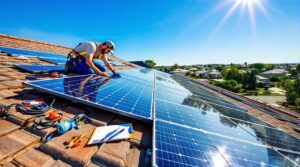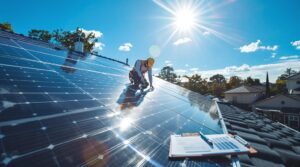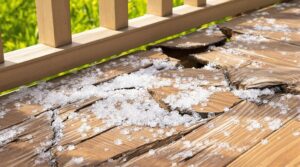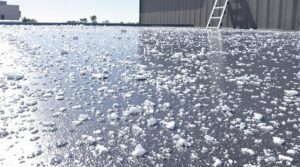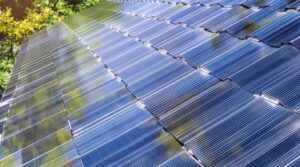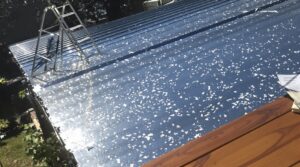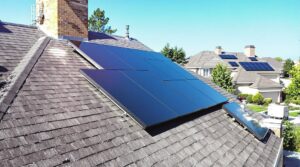Ever wondered if your solar panels can take a beating from Mother Nature's ice pellets? Well, you're in for some good news! Today's solar panels are tough cookies, specifically built to handle those nasty hailstorms that might keep you up at night.
Think of your solar panels as wearing a suit of armor – they're protected by ultra-strong 4mm tempered glass, similar to what you'd find in your car's windshield. These solar warriors are put through their paces during testing, having to stand up to hailstones as big as golf balls (25mm) before they even make it to your roof!
What's really impressive? Only a tiny fraction – about 0.1% – of solar installations report hail damage annually. That's like finding a needle in a haystack! These panels aren't just certified tough; they meet rigorous industry standards like IEC 61215 and UL 61730, which is basically like earning a black belt in weather resistance.
Want extra peace of mind? Consider getting a professional assessment of your setup. They can help you maximize your panel's protection and ensure you've got the right insurance coverage for those rare "what-if" moments when the sky decides to play a particularly aggressive game of ping pong with your roof.
Key Takeaways
Think Your Solar Panels Can't Handle Mother Nature's Ice Cubes? Think Again!
Let's dive into why today's solar panels are tougher than you might expect when it comes to hail. You know those rigorous IEC 61215 tests they put solar panels through? They're like a batting cage practice, with 25mm hailstones playing the role of fastballs!
What makes these sun-catchers so resilient? Picture a suit of armor made from 4mm tempered glass – that's what's protecting your investment, offering significantly better shield power than older 3.2mm designs. It's like comparing a medieval knight's armor to a paper shield!
Here's something that'll make you sleep better at night: only a tiny fraction – we're talking 0.1% – of solar installations ever report hail damage. Even if your panels take a few hits, they're like determined athletes – they'll keep performing, maybe not at peak efficiency, but they'll stay in the game unless seriously injured.
Want a pro tip? Think of your panels like a ski slope – the steeper the angle, the better they deflect those frozen projectiles. Installing them at an optimal tilt isn't just good for sun-catching; it's your first line of defense against nature's ice pellets!
Keywords: hail resistance, solar panel durability, impact protection, tempered glass panels, solar installation angle, weather-resistant solar, hail damage prevention, solar panel testing
Understanding Solar Panel Durability Against Hail
Nearly all modern solar panels are engineered to withstand significant hail impacts through a combination of rigorous design standards and advanced materials. The durability features incorporated into these systems include tempered glass construction and robust frame designs that meet or exceed industry standards such as IEC 61215 and UL 61730.
The material composition of solar panels plays an essential role in their hail resistance. Manufacturers subject panels to extensive testing, including simulated hail impacts with stones up to three inches in diameter at various velocities. Seasonal inspections are crucial for maintaining optimal performance and identifying potential damage early. Additionally, the design and structure of solar panels are engineered to enhance their resilience, ensuring that they can withstand extreme weather conditions. Solar panel durability against hail is an important consideration for both manufacturers and consumers, as it directly impacts the longevity and efficiency of the investment. By implementing robust materials and innovative designs, manufacturers aim to provide customers with peace of mind in regions prone to severe hail storms.
Solar panels undergo rigorous hail impact testing to ensure durability, with simulations using stones up to three inches in diameter.
The physical design, particularly the panel's installation angle, further enhances protection by helping to disperse impact forces. Statistical evidence supports these durability claims, with only 0.1% of solar panel systems reporting damage annually.
The panels' resilience is further validated through standardized testing methods that replicate real-world hail conditions, ensuring their ability to maintain functionality even under severe weather conditions. For maximum protection against severe weather, solar installations can be equipped with Leno Woven Hail Netting that features a one-inch mesh size to shield panels from impact damage.
The Science Behind Hail Impact Resistance
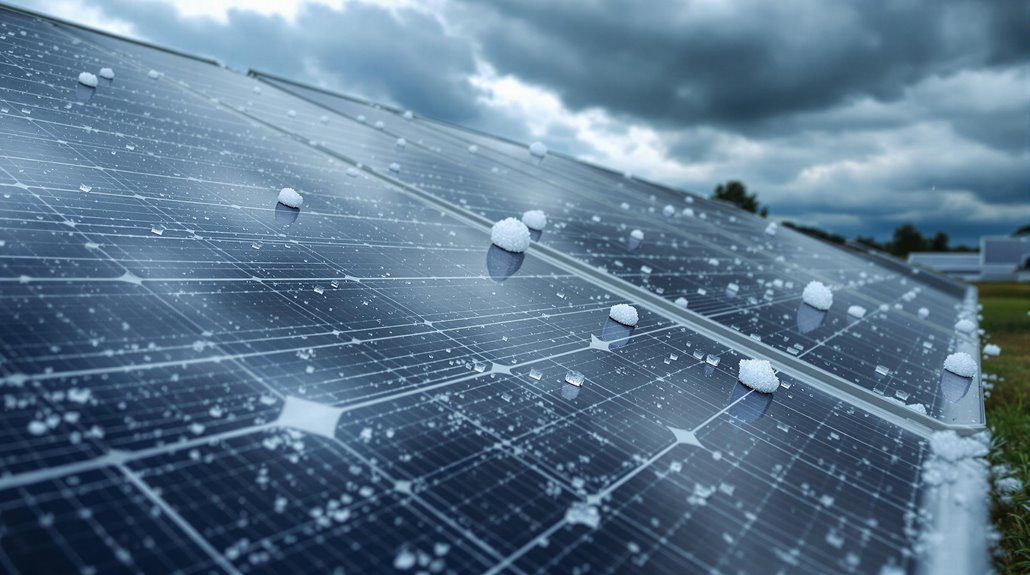
Understanding the science of hail impact resistance requires examining multiple physical factors that determine a solar panel's ability to withstand damage. Impact mechanics play a vital role, as hailstone velocity and size directly influence the force applied to the panel surface. Material science research shows that glass thickness of 4mm substantially enhances resistance compared to thinner alternatives.
The physics of impact distribution varies with installation angle, as steeper orientations can effectively disperse kinetic energy. When hailstones strike panels, they can create both visible damage and microscopic fractures. Studies indicate that professional representation through qualified adjusters leads to 500% higher settlements for non-catastrophe claims.
These micro-cracks, while not immediately apparent, can develop into serious structural compromises over time, potentially leading to hotspots and electrical failures. Laboratory testing reveals that impact resistance correlates strongly with panel construction quality, particularly in the integration of tempered glass and reinforced frames. This scientific understanding has led to the development of industry standards requiring panels to withstand impacts from 25mm hailstones. Many homeowners choose to work with public adjusters to properly document and assess hail damage for insurance claims.
Solar Panel Certification and Safety Standards
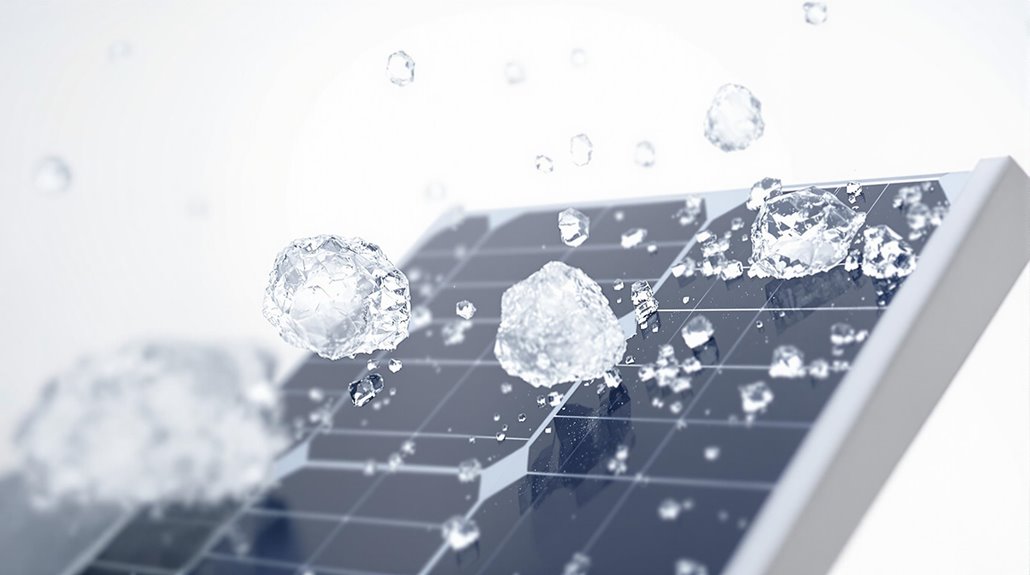
Solar panel certification and safety standards form a thorough framework of international requirements that verify photovoltaic modules meet rigorous quality, performance, and durability benchmarks.
Testing protocols such as IEC 61215 specifically address hail impact resistance, requiring panels to withstand 25mm hailstones.
Multiple certification requirements work together to ensure complete safety and reliability.
- IEC 61730 evaluates construction safety and electrical design standards
- UL 1703 provides mandatory North American certification for harsh conditions
- IEC 61701 tests salt mist resistance for coastal installations
- IEC 62716 assesses ammonia corrosion resistance for agricultural settings
- ISO 9001 ensures consistent manufacturing quality standards
These certifications, overseen by recognized bodies like the International Electrotechnical Commission and Underwriters Laboratories, establish measurable benchmarks for solar panel performance.
Manufacturers must demonstrate compliance through standardized testing methods, which verify their products can withstand environmental stresses while maintaining safety and functionality over time.
Real-World Performance in Severe Weather

Real-world evidence demonstrates that modern solar panels exhibit varying degrees of resilience during severe hail events. Panel performance post-impact can continue at reduced efficiency levels, with damage typically manifesting as microcracks that affect short-circuit current and increase series resistance. In some instances, electrical separation occurs, rendering portions of cells non-functional. The extent of these hail damage effects on solar panels can greatly depend on the design and materials used in their construction. For instance, panels with enhanced protective coatings or robust glass are often better suited to withstand such impacts, minimizing long-term performance degradation. Additionally, regular inspections and maintenance can help identify and mitigate the effects of any potential damage, ensuring optimal energy production over the lifespan of the solar system.
Weather performance analysis indicates that panel resilience depends substantially on structural elements, particularly glass thickness. Panels featuring 4mm glass demonstrate superior impact resistance compared to standard 3.2mm variants, though microcracks remain possible.
Notable incidents at solar installations in Texas, Nebraska, and Colorado have highlighted the vulnerability of standard panels to large hailstones, resulting in substantial financial losses. However, technological advancements in tempered glass, frame construction, and protective coatings continue to enhance hail resistance. These improvements, combined with rigorous testing protocols simulating ice projectiles, are progressively strengthening panel durability in severe weather conditions.
Protecting Your Solar Investment From Hail Damage
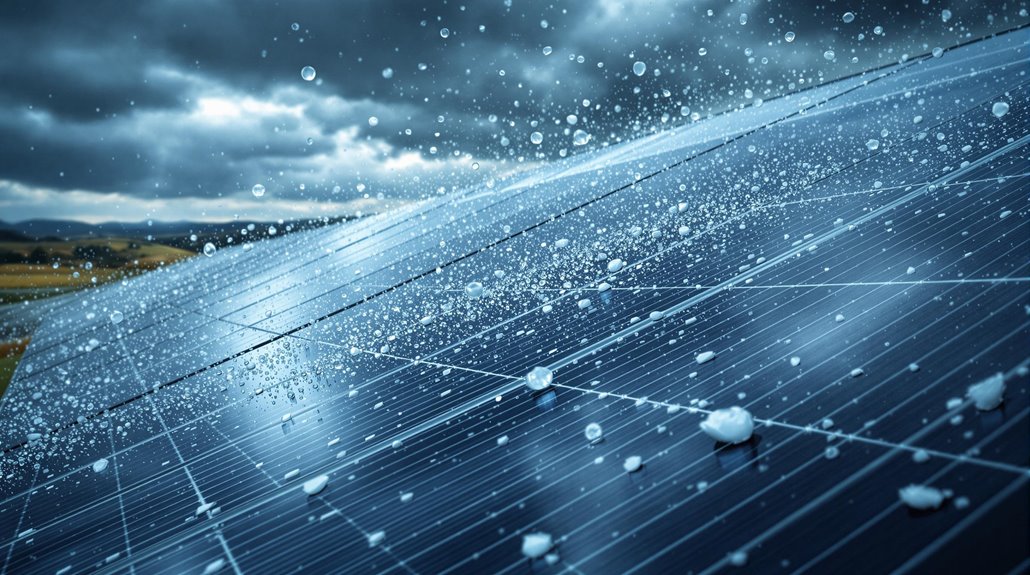
Safeguarding solar panel installations from hail damage requires a multi-faceted approach incorporating both strategic equipment selection and preventative measures.
Installation planning plays a vital role, with steeper panel angles providing enhanced protection against direct hail impacts.
Selecting panels with UL 61730 certification guarantees maximum resilience, as these units are tested to withstand hailstones up to three inches in diameter at speeds of 88.3 mph.
- Implement protective gear such as specialized covers during severe weather events
- Choose panels with IP68 rating for superior waterproof and dustproof protection
- Install panels at ideal angles based on geographical hail patterns
- Apply protective coatings or sprays to enhance impact resistance
- Conduct regular inspections to identify potential vulnerabilities
For regions prone to frequent hailstorms, such as Texas, Colorado, and Nebraska, additional protective measures may be necessary. This includes strategic placement of panels and the utilization of supplementary protective equipment designed specifically for severe weather conditions.
Insurance Coverage and Warranty Considerations
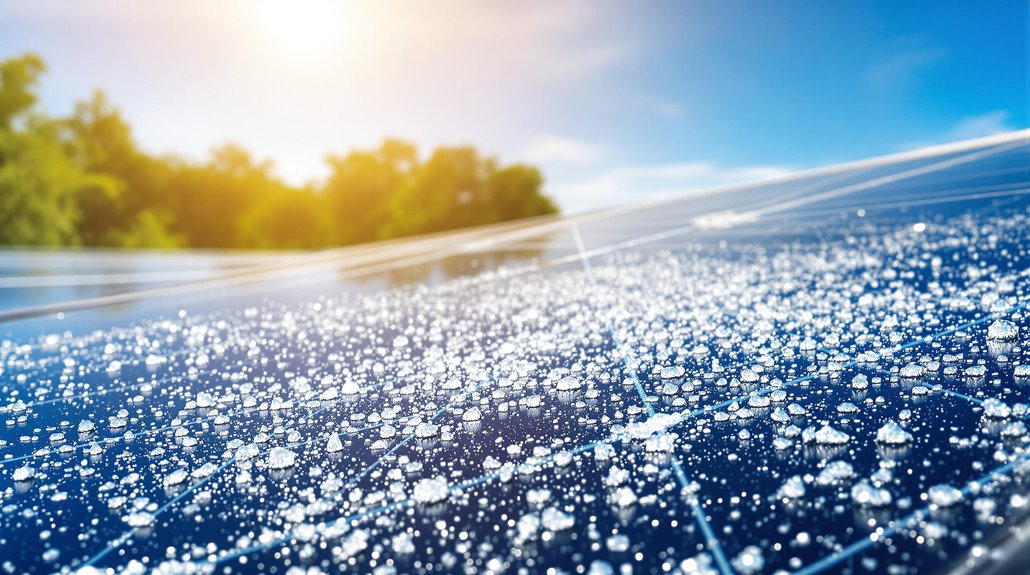
While most homeowners' insurance policies include solar panels under their dwelling coverage, the specific terms and limitations regarding hail damage require careful examination.
Insurance exclusions may apply, particularly for ground-mounted or carport installations, which often necessitate separate coverage options.
Warranty considerations present additional complexities, as standard manufacturer warranties typically exclude hail damage. Insurance adjustments experts can document damage thoroughly through timestamped photographs and professional assessments.
With average hail claims reaching $58.4 million per incident, the financial implications of inadequate coverage can be substantial. Some manufacturers offer enhanced warranty terms that provide limited hail protection, though these usually involve specific conditions and may increase costs.
Insurance regulations vary by region, making it essential for solar panel owners to verify their coverage details and understand potential gaps.
Certified panels meeting UL 61730 and IEC 61730 standards demonstrate tested hail resistance, which may influence insurance terms and premium rates.
Homeowners should consider consulting public insurance adjusters who specialize in documenting and maximizing hail damage settlements for optimal coverage outcomes.
Regional Hail Risk Assessment for Solar Installations
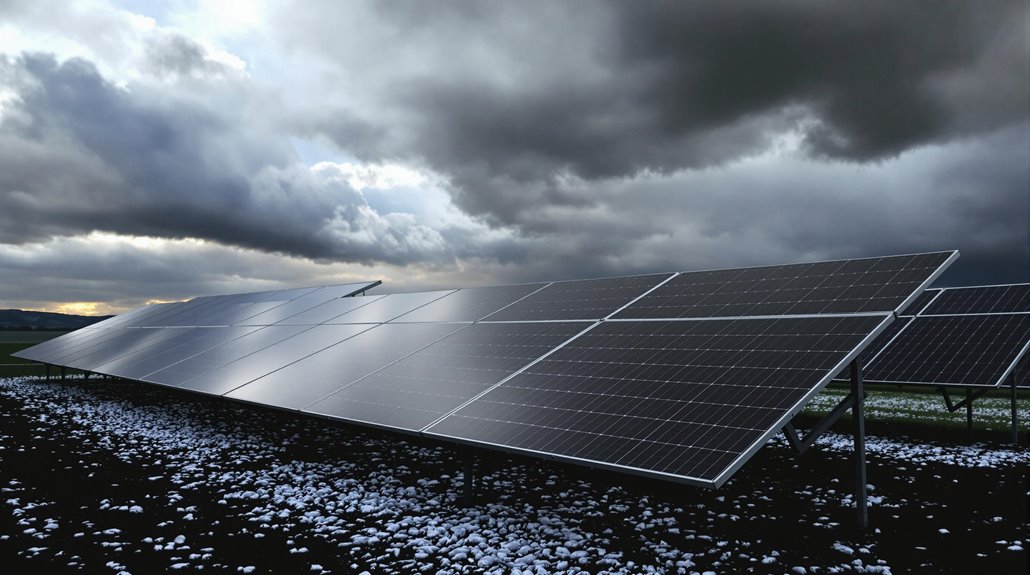
Regional hail risk assessment provides a foundation for strategic solar installation planning and long-term system protection.
Through advanced weather analytics and hazard mapping tools, stakeholders can evaluate site-specific vulnerabilities and implement appropriate protective measures.
The integration of historical data from NOAA's severe weather database with FEMA's National Risk Index enables thorough risk analysis at the county level.
- VDE Hail Risk Atlas on Esri ArcGIS platform offers detailed geographical risk assessments
- NOAA Severe Weather Data provides historical patterns of hail events
- FEMA's National Risk Index categorizes hail risks from very low to very high
- FM Global Natural Hazards Map tracks hail size and frequency distributions
- Local weather service data enables micro-level risk evaluation
These assessment tools facilitate data-driven decision-making for solar installations, incorporating factors such as hailstone size probability, impact velocities, and seasonal weather patterns.
Hail Alley regions like Nebraska, Colorado, and Wyoming require particularly robust protection strategies due to frequent hail events.
This systematic approach to risk evaluation helps optimize site selection and determine appropriate protective measures for solar assets.
With powerful updrafts reaching speeds of up to 110 mph during severe storms, understanding local atmospheric conditions is crucial for protecting solar installations.
Long-Term Benefits Despite Weather Challenges
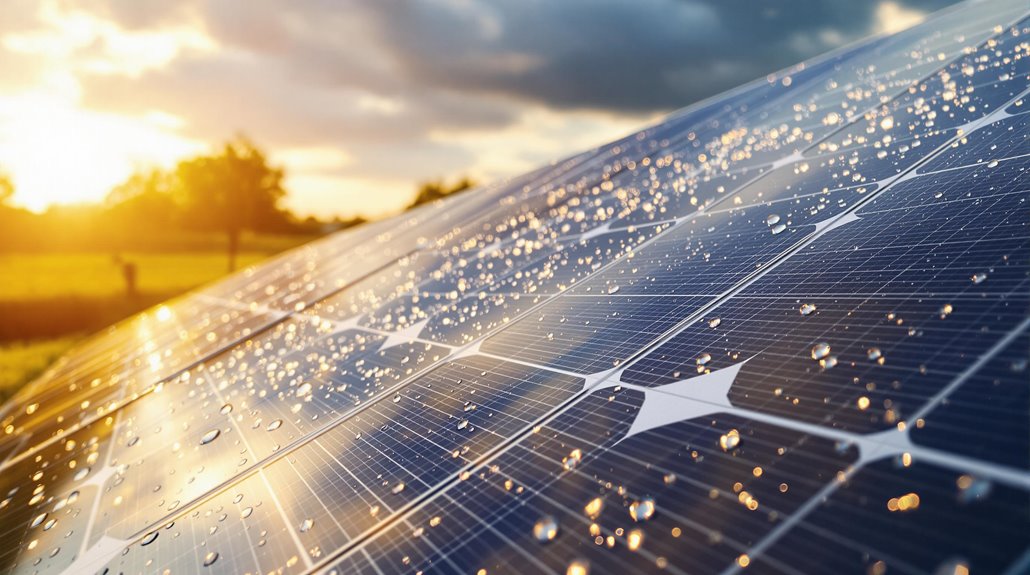
Despite potential weather-related challenges, solar panel installations demonstrate considerable long-term benefits through their engineered resilience and technological advancements. Modern panels, constructed with tempered glass and robust frames, consistently maintain sustainable performance against hail impacts up to three inches in diameter at speeds under 88.3 mph.
| Feature | Benefit |
|---|---|
| 4mm Glass Thickness | Enhanced Impact Protection |
| UL/IEC 61730 Standards | Verified Durability |
| Hail Stow Technology | Active Storm Defense |
The economic resilience of solar installations is further strengthened through innovative protective measures and strategic design choices. Proper installation techniques, combined with advanced tracking systems and protective coatings, considerably reduce weather-related risks. While micro-cracks may develop over time, ongoing technological improvements and adaptation strategies help maintain peak energy output. These factors, coupled with the panels' role in achieving carbon neutrality, reinforce their position as a robust long-term investment in renewable energy infrastructure.
The Benefits Of Consulting A Public Adjuster For Hail Damaged Solar Panel Home Insurance Claims
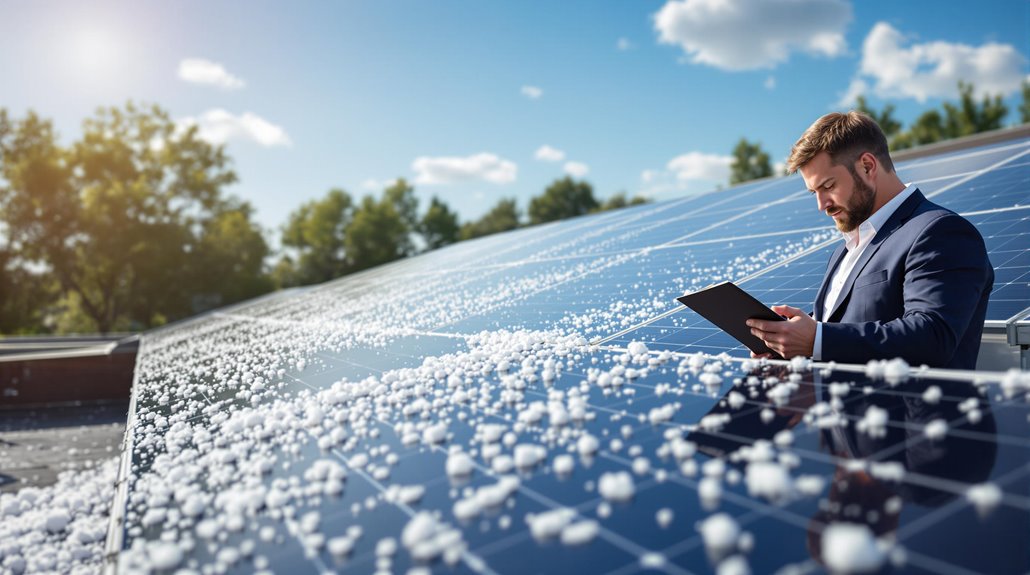
Public adjusters provide specialized expertise in handling complex insurance claims for hail-damaged solar panels, offering objective damage assessments independent of insurance company interests.
Their professional involvement typically results in higher claim settlements through detailed documentation, thorough understanding of policy coverage, and skilled negotiation with insurance providers.
The streamlined claims process managed by public adjusters reduces administrative burden on homeowners while maximizing the likelihood of complete compensation for solar panel damage.
Statistics indicate that homeowners who work with public adjusters receive settlements increase $3,600 more compared to those who file claims independently.
Working with public adjusters who charge success-based fees of 10-20% ensures their commitment to maximizing claim value.
Expertise In Insurance Claims
Insurance claims for hail-damaged solar panels present complex challenges that often require professional expertise to navigate effectively.
Public adjusters provide specialized Claims Expertise in documenting damage, interpreting policy provisions, and securing maximum settlements. Their thorough Insurance Documentation approach guarantees all aspects of damage are captured, including hidden issues like micro-cracks and electrical malfunctions. Delayed claim filings can result in significant financial losses and potential structural complications.
- Thorough assessment of visible and concealed damage through professional documentation methods
- Expert interpretation of policy terms, coverage limits, and exclusions
- Strategic negotiation with insurance carriers for complete settlements
- Integration of local regulations and renewable energy incentives into claims
- Management of complex removal and reinstallation cost considerations
Professional adjusters understand the intricate relationship between solar systems and roofing structures, enabling them to address unique challenges that arise during the claims process.
Homeowners who work with public adjusters receive an average of $3,607 more in claim settlements compared to those who handle claims independently.
Objective Damage Assessment
Professional damage assessment requires sophisticated diagnostic methods to accurately evaluate hail-impacted solar installations. Inspection techniques combine visual examination with advanced testing protocols to identify both apparent and concealed damage indicators.
| Assessment Method | Detection Capability | Implementation |
|---|---|---|
| Visual Inspection | Surface damage | Immediate examination |
| Electroluminescence | Micro-cracks | Laboratory testing |
| Performance Analysis | Efficiency loss | SolarEdge monitoring |
| Documentation | Historical records | Photo evidence |
| Mismatch Testing | Output variations | Comparative analysis |
The assessment process employs multiple diagnostic tools, including electroluminescence testing for detecting microscopic cell damage and performance monitoring systems that track efficiency changes. These objective measurements provide quantifiable data essential for insurance claims and remediation planning, ensuring thorough evaluation of hail-impacted solar systems. Engaging public adjusters typically results in higher settlement amounts compared to homeowners handling claims independently. A comprehensive damage inventory should be created immediately after the storm to document all affected solar panel components.
Streamlined Claim Process
Following thorough damage assessment, property owners often benefit from engaging specialized claims experts to navigate the complex process of insurance recovery. Recent data shows that policyholders using expert claim assistance typically secure higher settlements averaging over $22,000 for hail damage claims.
Public adjusters streamline the claims process through efficient processing of documentation and negotiation with insurance providers, leading to expedited settlements for hail-damaged solar panels.
- Provides structured documentation of all visible and hidden damage to solar panel systems
- Leverages expertise in policy interpretation to maximize coverage benefits
- Implements strategic negotiation approaches with insurance carriers
- Guarantees accurate cost estimation for repairs or replacements
- Saves time through professional management of claim paperwork and communications
Public adjusters work on a commission basis, aligning their interests with achieving maximum settlement amounts.
Their specialized knowledge of hail damage claims and insurance industry standards enables faster resolution while protecting the policyholder's interests throughout the process.
Studies show that homeowners who utilize public adjuster services receive settlements up to 800% higher than those who file claims independently.
Higher Claim Payouts & Settlements
When property owners engage public adjusters for hail-damaged solar panel claims, they typically receive settlements 40-50% higher than self-managed claims. Claim statistics indicate that hail damage accounts for 54.21% of total solar loss claims, making professional representation essential for settlement optimization.
Public adjusters leverage their expertise to thoroughly document damage, navigate complex policy terms, and negotiate effectively with insurance companies. Public adjuster claims average $22,266 compared to DIY settlements.
Their thorough understanding of manufacturer warranties, insurance coverage gaps, and consumer protection laws enables them to maximize claim values. These professionals guarantee all damages are properly assessed and documented, reducing the likelihood of arbitration while increasing the probability of favorable settlements. The contingency-based fee structure incentivizes public adjusters to secure maximum payouts for property owners with damaged solar installations.
Studies show that professional claim settlements often average 300-400% more than initial insurance company offers.
About The Public Claims Adjusters Network (PCAN)
The Public Claims Adjusters Network (PCAN) serves as a critical intermediary in processing insurance claims for solar panel damage, particularly in regions where hail incidents are prevalent.
Through their Claims Specialists and Insurance Partnerships, PCAN facilitates thorough assessments of damaged solar installations and guides homeowners through complex claim procedures.
- Provides expert evaluation of hail damage to solar panel systems
- Assists in documenting physical damage and performance degradation
- Coordinates with insurance providers to guarantee proper coverage assessment
- Leverages technical expertise to validate repair or replacement costs
- Ensures compliance with local regulations and warranty provisions
PCAN's involvement becomes especially valuable in areas like Texas, Colorado, and Nebraska, where frequent hailstorms pose significant risks to solar installations.
Their expertise in traversing insurance policies and understanding technical specifications helps property owners secure appropriate compensation for damaged solar equipment, while maintaining adherence to certification standards such as UL 61730 and IEC 61730.
Frequently Asked Questions
Can Solar Panels Be Recycled if Damaged Beyond Repair by Hail?
Damaged solar panels can be processed at specialized recycling facilities, where material breakdown procedures recover valuable components including silicon, glass, aluminum, and other metals for reuse in manufacturing processes.
How Does Extreme Temperature During Hailstorms Affect Solar Panel Performance?
Solar panels operating outside their ideal 15-35°C range experience significant efficiency losses. During hailstorms, rapid temperature changes create thermal stress, potentially reducing performance through micro-crack formation and conductivity impacts.
Do Solar Panels Make Hail Noise Louder Inside the House?
Research indicates no significant correlation between solar panels and increased interior hail noise. Sound insulation and interior acoustics are primarily influenced by attic insulation and roofing material composition.
Can Solar Panels Be Temporarily Deactivated During Predicted Hailstorms?
Temporary deactivation of solar panels during hailstorms is not standard practice. While emergency shutoffs exist, protective coverings offer more effective protection against hail damage than system deactivation.
Are Solar Panel Cleaning Services Necessary After Minor Hail Damage?
Professional cleaning services are typically unnecessary after minor hail unless significant debris removal is needed. Standard panel maintenance inspections should focus on structural damage assessment rather than surface cleaning.
References
- https://skyfireenergy.com/hail-vs-solar-panels/
- https://enact.solar/how-durable-are-my-solar-panels-in-extreme-weather/
- https://blog.ecoflow.com/us/how-to-protect-solar-panels-from-hail-storm-damage/
- https://www.energysage.com/solar/solar-panels-hail-hurricanes/
- https://www.solarreviews.com/blog/solar-panel-hail-damage-what-you-need-to-know
- https://todayshomeowner.com/solar/guides/can-solar-panels-withstand-hail/
- https://blog.namastesolar.com/hail-solar-panels-how-much-hail-can-solar-panels-handle
- https://ceramics.org/ceramic-tech-today/protecting-solar-panels-from-hail-the-thicker-the-glass-the-better/
- https://research.vu.nl/ws/portalfiles/portal/99414733/Final_public_report_Vulnerability_of_solar_panels_to_hail_risk.pdf
- https://www.roperroofingandsolar.com/solar-panel/can-hail-damage-solar-panels/
